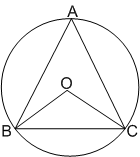 Multiple Choice Questions
Multiple Choice QuestionsThe chord AB of a circle of centre O subtends an angle θ with the tangent at A to the circle. Then measure of
θ
90° - θ
90° + θ
2 (180° - θ)
XYZ is a right angled triangle and ∠Y = 90°. If XY = 2.5 cm and YZ = 6 cm, then the circumradius of Δ XYZ is:
6.5 cm
3.25 cm
3 cm
2.5 cm
A 8 cm long perpendicular is drawn from the centre of a circle to a 12cm long chord. The diameter of the circle is
10 cm
12 cm
16 cm
20 cm
Δ ABC a right-angled triangle has ∠B = 90° and AC is hypotenuse. D is its circumcentre and AB = 3 cm, BC = 4 cm. The value of BD is:
3 cm
4 cm
2.5 cm
5.5 cm
C.
2.5 cm

AB = 3cm and BC = 4 cm
In Δ ABC,
(AC)2 = (AB)2 + (BC)2
AC2 = (3)2 + (4)2
AC2 = 9 + 16
AC2 = 25
AC = 5 cm
Radius = BD = AD = DC = Radius
![]()
If a circle of radius 12 cm is divided into two equal parts by one concentric circle, then radius of inner circle is
6 cm
4 cm


Two circles touch externally. The sum of their areas is ![]() and the distance between their centres is 14 cm. The radius of the bigger circle is
and the distance between their centres is 14 cm. The radius of the bigger circle is
22 cm
11 cm
33 cm
44 cm
If S is the circumcentre of Δ ABC and ∠A = 50° then the value of ∠BCS is
20°
40°
60°
80°
BC is the chord of a circle with centre O. A is a point on major arc BC as shown in the above figure. What is the value of ∠BAC + ∠OBC = ?
120°
60°
90°
180°
Two circles with radii 5 cm and 8 cm touch each other externally at a point A. If a straight line through the point A cuts the circles at points P and Q respectively, then AP : AQ is
8 : 5
5 : 8
3 : 4
4 : 5
AC and BC are two equal chords of a circle. BA is produced to any point P and CP, when joined cuts the circle at T. Then,
CT : TP = AB : CA
CT : TP = CA : AB
CT : CB = CA : CP
CT : CB = CP : CA
